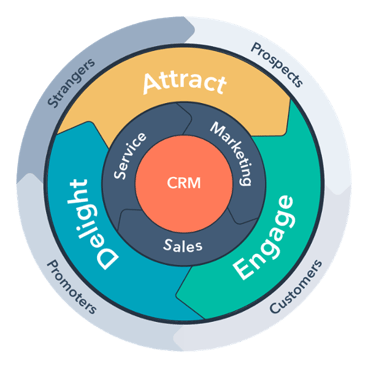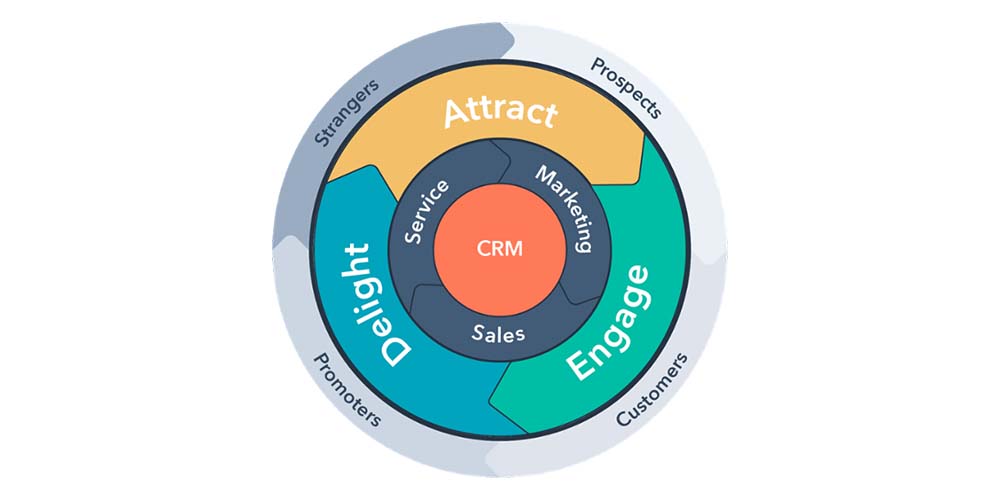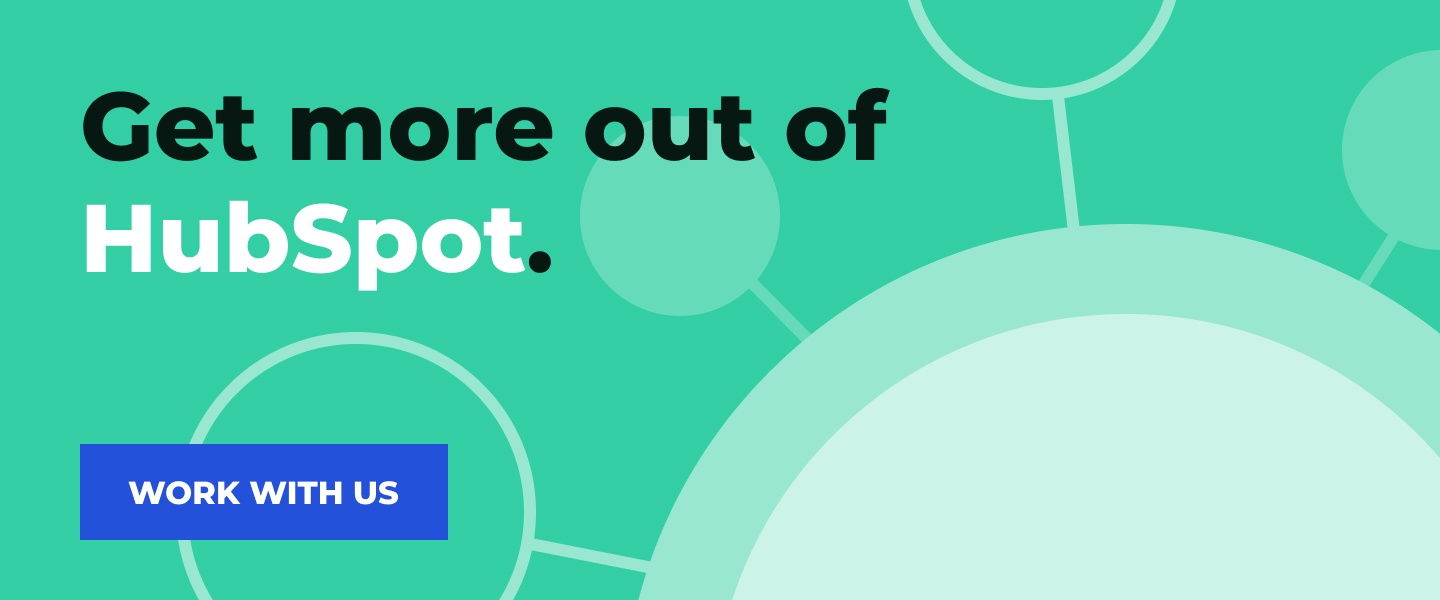What’s the greatest thing about circles?
They never stop. So what if you could get your marketing efforts (and results) moving in a circle that never stopped?
Boom. You can with the flywheel model.
Adapted by HubSpot CEO Brian Halligan, the flywheel is a new way of looking at traditional marketing funnels. Instead of three stages that gradually weed out unqualified leads, the flywheel focuses on building a positive customer experience that turns people into brand advocates.
To help explain all the details and benefits of the marketing flywheel, I chatted with Chris Hanaway, Marketing Consultant / circle extraordinaire. But before we dig into this methodology, let’s take a quick look at why the marketing funnel is falling behind in the first place.
Limitations of the Marketing Funnel
Your first thought might be, “The marketing funnel has worked in the past, why should I change?” A valid question. The answer has to do with the complexities of the customer journey.
“The current marketing funnel model is a very linear process,” Chris explains. “It assumes that there are clear pathways through the buyer’s journey and once they’re through the funnel, they’re just through. They’re customers now, the end. It really ignores that post-purchase status and part of the journey.”
Chris adds that a marketing funnel also neglects to consider all of the external factors potential customers face on the path to purchase. Things like a barrage of media messages, paid ads on every platform and a never-ending stream of email marketing.
All of these can distract potential customers, pulling their attention away from your brand. So although you convinced them to purchase once, there’s no guarantee that you can get them to do it again.
“The great thing about the flywheel is that it’s circular, so no one ever really gets through it,” Chris says. “They make a purchase decision, have a good experience, rebuy from your brand and tell people all about it. It creates an environment where those happy customers can go out and evangelize for your brand.”
With this in mind, he notes that marketing funnels are not always a bad choice. They tend to work well for big companies with large budgets that can invest in both paid and organic efforts to populate their funnel and build brand awareness. However, smaller companies that rely on repeat customers often can get more out of the flywheel approach.
What Is the Flywheel?

So how is the flywheel different?
In the flywheel model, your business revolves more around your customers and less around constantly generating and converting new leads. You not only want customers to buy from you, you want them to buy from you again and (perhaps more importantly) spread the word about your company.
To create happy customers who are willing to advocate for you, you have to focus on not only converting them, but delighting them in the post-purchase phase of their journey. You need to make their experience with your brand memorable, easy and enjoyable.
“The flywheel creates a world where positive customer interactions fuel brand growth,” Chris explains. “It’s all about customer satisfaction creating momentum for brands to find success.”
He adds that once you get that momentum going, it can keep your flywheel moving without much input from you. As people recommend your product or service, their friends will enter your flywheel and start their own journey. Over time, you’ve created a lead generation machine that continually feeds off of your customers’ positive energy.
How It Works
The flywheel works by uniting your sales, marketing and service teams through your CRM. Each team manages a different aspect of the customer experience to ensure you’re supporting the entire customer journey.
Similar to the three stages of a marketing funnel, there are three phases in the flywheel:
- Attract new customers via word-of-mouth and inbound marketing efforts.
- Engage prospective customers with valuable content and personalized information.
- Delight existing customers by going the extra mile to ensure they have a positive experience.
Through these three phases, you turn strangers into prospects, then customers, then promoters who are not only loyal to your brand but willing to advocate for it.
Pros and Cons
Sounds like a pretty foolproof system but, like most things, there are some pros and cons to using the flywheel model. I’m a grand optimist, so we’ll start with the good things about it.
Chris notes that the flywheel is focused on creating a loyal customer base, which makes it easy to scale with your business. The more people have a positive experience with your brand, the more they’ll tell others about it and bring those new leads into your flywheel and so on. This helps you gain momentum and expand your customer base quickly.
“It can scale how you want it to scale so that you can grow quickly but under control.”
He also likes that the flywheel addresses the post-purchase journey — an area where the marketing funnel is lacking.
“The flywheel never really acknowledges that someone has completed their journey,” Chris says. “It sees the customer as a forever part of the brand, so you never really lose touch with a customer who’s already bought in.”
He adds that once you have someone who’s bought into your brand, you can continually engage them with new content, offers and perks of being part of the “in crowd.” This delightful post-purchase experience then turns them into brand advocates.
Despite these benefits, there is one drawback that Chris mentions.
“The flywheel can only be maximized if you don’t have any barriers in your own organization. As good as it is, it has a hard time overcoming internal issues such as bad software, bad processes or other things that get in the way of optimizing business.”
He recommends you ensure all of your internal processes and tools are running efficiently and that you have a clear marketing strategy in place if you want to get the most out of a flywheel model.
How to Build Your Flywheel
Just like your marketing funnel, your flywheel relies heavily on your content. However, in this marketing model your content is part of a positive customer experience. Here’s how you can make those two things work together to help generate, convert and keep customers.
Content Marketing
marketing funnels and flywheels are both composed of multiple types of content, all tailored to the customer journey. Flywheels, however, put a particular emphasis on customer-centric content.
This model relies somewhat on happy customers recommending your brand and introducing new customers to your products or services. This is almost like your top-of-funnel content. Current customers will give people basic information, then send them to your site to learn more.
That’s why it’s important to focus on those mid and bottom-of-the-funnel content pieces like case studies, testimonials or client stories. This provides proof that all the good things someone has heard about your brand is true.
“It’s critical that you’re always providing value in your content,” Chris says. “Create things that show you empathize with where people are in their journey and that you have a solution for them. Your content has to be valuable and worthy of their attention.”
Customer Experience
Next up is customer service. It has to be best-in-class. And to accomplish that, all of your teams will play a role in creating a positive customer experience. Aside from your customer service team, it’s critical that you align your sales and marketing teams to expertly manage the beginning stages of the customer journey and create a smooth lead handoff.
Your marketers can create onboarding workflows, product tip sheets and develop a Knowledge Base. The sales team can spearhead referral, upsell and cross-sell programs. The trick is to make sure that these two teams are handing off customers at the right time and with the right information for each other to continue moving them forward.
“You can always put the customer first,” Chris asserts. “Take a consumer-first approach to all of your marketing endeavors and the rest will follow.”
He recommends a few simple tactics to help make your marketing more consumer-centric:
- Create content that celebrates how to get the most out of your product or service.
- Offer expert advice that feels exclusive for existing customers.
- Tailor your messaging to fit your target audience’s needs and pain points.
- Create customer feedback loops within your customer service team to continually gauge their experience and find opportunities for improvement.
Industries That Benefit
As we’ve mentioned, the flywheel naturally lends itself to the inbound methodology. So any business relying on that as part of their marketing strategy could implement the flywheel in their business. However, it works particularly well for B2B companies.
“The flywheel for B2B is super important,” Chris says. “That consumer is a much more specialized, niche market where expert information is critical.”
He continues that the products and services B2B companies sell are typically more mission critical for their clients. And when making those big decisions about their business, most clients are looking for trusted, expert support.
“The benefit of the flywheel is that it’s really fueled by the opinions of your customers. Consumers are seeking out trusted partners to help them meet business critical needs. So if you can have your customers advocating on your behalf to a highly qualified audience, that’s highly valuable.”
Chris points to the EdTech industry as an example. Their unique position means they’re often promoting products to audiences that aren’t necessarily the decision maker in their organization — i.e. teachers in a school district. But by creating a positive customer experience for other clients, they would have a bank of people willing to vouch for the value of their product.
“It helps to ensure that they have customers advocating for their product or service, regardless of if they’re decision-makers or not. That helps to build momentum and fuel brand growth by ensuring that conversations about your brand are always positive, which drives people to want to learn more.”
He adds it also lends itself to industries that have a long sales cycle. When you focus on creating a great customer experience that fosters repeat customers, you don’t have to invest as much time into lead nurturing and closing deals to make sure you’re reaching your financial goals. You can create a stable base of returning clients and instead focus on business growth through your flywheel efforts.
The Circle of Trust
The flywheel is more than a marketing or business strategy. It’s a way to your customers at the heart of your business. The more you attract, engage and delight customers, the more trust you build with them as you solve their problems.
As you implement this new type of marketing funnel in your business, just remember that every marketing material, touchpoint in your sales process and follow up post-purchase should be focused on customer success. When they win, you win.
For more on how you can best support your customers, check out our blog about HubSpot’s Service Hub.








